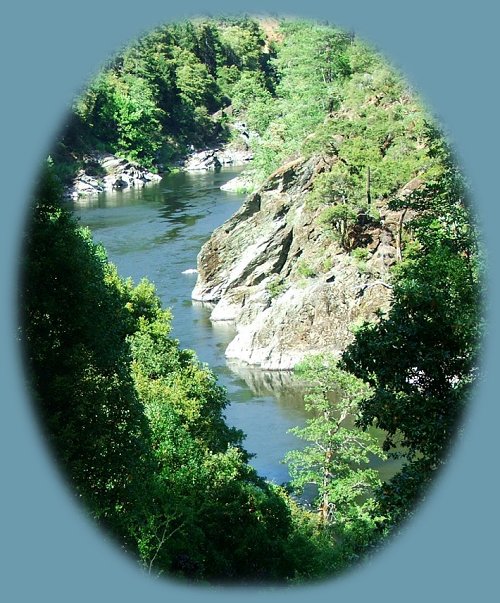|
The wild and scenic Klamath River The Shasta Tribe called the river Klamet, the Karuk Ishkêesh. The current rendering comes from the Hudson Bay trappers. Forward ~ Shortcut Directions to the wild and scenic Salmon River and other information. Back ~ Rafting on the Smith River in northern California. Sights to see on the Salmon, Scott and Klamath Rivers. USFS: Klamath National Forest. The mighty Klamath River, the river the tore out the bridge at Klamath, California in the 1964 flood, flows 240 miles to the Pacific ocean. It has been divided by rafters. The Upper Klamath is that which flows in Oregon and the lower in California. Most people spend their time, as we did on the trip when these photographs were taken, on the stretch of the Klamath in California. |

|
|
No matter the upper or the lower, the Klamath River offers much of interest. Not the least being the gold mining history of the area, the class IV rapids in the upper Klamath. Ishi Pishi falls in the lower, just downstream from Somes Bar, are counted as either class V+ or class VI rapids, depending on the flow of the river. The Upper offers some pretty hairy rides for rafters, the measure of waterflow depending on the amount of water released at John Boyle Dam. The river below Iron Gate Dam has been declared wild and scenic, but considering the health of the river, that seems an anomaly. Laughable, perhaps, but not really. (See below.) The upper Klamath offers a variety of sightseeing, rafting, and general recreation opportunities. The road along the river at this point is dirt, so plan for that. Also, the upper Klamath River is not suitable for kayakers. Rafting yes, kayaking no. :-) The lower is a veritable smorgasbord of recreational opportunities. Brad and I always combine this journey with other goals in mind. We drive along the Klamath when going to the Redwoods, when traveling along the Trinity, and when making a loop for one of the forks of the Salmon and the Salmon River gorge. The lower Klamath River offers rafing, canoeing, kayaking, hiking trails, camping, beautiful sightseeing of nature and the old west. The Enduring River ...Only recently, in the past few years or so, did I start to give the Klamath River some credit. Not that I didn't stop outside of Keno, Oregon on Hwy 66, and marvel at the gorge, with the river flowing down there below me. I especially like the river in the spring when the banks are drenched in the blossoms of blooming redbuds, when the creeks flowing into the Klamath are high from snowmelt, some of those creeks are exceptionally beautiful. The Williamson River, a tributary in Oregon, is remarkable geologically, for the untamed gorge that has no trail, but is wonderful to hike, I could go on and on about the wonders of this river system. And yes, I enjoyed it all. Still, I just kind of shuffled the river aside, so to speak. Because it's suffering, and I guess I felt helpless to make a change. Even though I have advocated for the river at different times. Advocating for the river is difficult because a small, and today, a powerful, special interest group lobbies on behalf of interests that are certainly contrary to the interests of the river and those of us who are not farmers and ranchers in Klamath Basin. Irrigation practices and pesticide use along the tributaries and Klamath Lake in the Klamath Basin are killing the river. Silly reason to shuffle it aside, isn't it? Unfortunately, it seems many are doing exactly that. Even the rafting sites. Rafters give the river credit despite the "brown water and suds", as they describe it. Yet, even in that description is an acceptance, a sort of shuffling aside. Now, I've made the river a cause in this regard. While I enjoyed the river in the past, I now feel it important I advocate both for the wonder of this watershed and what is being destroyed in the interests of the few and for the river, beautiful and ever flowing as it is. Rafters speak of the lower Klamath as being runnable for several hundred miles, giving it a great HooRay. Speaking of the brown water and suds, they attribute this to the shallow waters of Klamath Lake, which is eutrophying, i.e., drying up, a natural process for any lake, it's true. However, the lake isn't just eutrophic, it's hypereutrophic, and this state is attributed to land use practices. Geologists concede that the lake was probably eutrophying prior to settlement by non-Native Americans, but now that it's hypereutrophic, the blame and responsibility for this state can be laid firmly on the shoulders of humans. We can do something about this. I'm only mentioning this because the river is beautiful, it's situated in some of the most beautiful scenery one can ever hope to see. Some of the tributaries, especially the Salmon River, which I love, are exceptional. I tell you this in the hopes that common cause can bring about change in the river and those of us, many - much more than the few who take the river at the headwaters for their own personal goals with no regard for anyone else, and make a change. | |
|
|
Travel along the Klamath River in northern California to the retreat: Directions & Scenery on the Klamath as well as the Salmon & Scott rivers. Enjoy the free flowing Salmon River, hiking trails, waterfalls, rafting, picnicking, the forest, wildflowers in spring, autumn colors in fall ... Directions to and Day Trips of about 100 miles from the retreat. Little known Scenic Places near the retreat and Crater Lake National Park: Directions, Map and Scenery. Website Directory for the travel pages Home Page |
|
Contact Brad at Gathering Light ... a retreat. | |